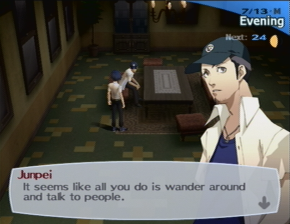October 1st, 1997: Never Forget.
Haven’t updated in nearly a month, and figured I should. Here’s what I’ve been up to.
P3: FES is one hell of a game. Whether that is a good or a bad hell depends on your taste, but it’s epic in scale and I still think back on it months later. I am really looking forward to P4, which was recently announced for a release date of December 9th stateside.
P.T.O. 4 is somewhat lackluster. Pacific Theatre of Operations was one of Koei’s little strategy-sim experiments in the SNES days. At the time, it felt too complex for its own good. The PS2 edition (which I hadn’t known existed until just a week ago) is either far too complex or far too simple. The game recommends you automate ship development, plane management, and politics – which leaves you with management of your navy officers and your navy itself, which feels far too simple. Battles are done by giving your fleets vague objectives (sometimes they even listen) and you usually want to take out enemy airports. It feels sort of like half a game with automation, but after a brief look at ship-building, it looks like I could spend weeks trying to figure it out. I’m probably just not going to bother.
Chrono Trigger, meanwhile, is still a great game. My tastes have changed since I was younger and I now favor games with more strategy and dialogue, but CT is certainly among the best of its generation and, like Lord of the Rings, will stick in my mind as an example of what the medium can do. I have found many fantasy novels that build on LotR, but few can match its depth and remain so concise. CT’s pace is nearly breakneck (few dungeons take more than a half hour) which is a big refresher after games that take 10 hours to ramp up the plot. I wonder if that makes Chrono Cross the Silmarillion or the Unfinished Tales? Either way, it is my current project.
I am continuing my hacking forays into the NES game Destiny of an Emperor. I have updated the officer editor with a portrait preview feature and have been gradually working on a script editor (which does not yet have its own page). I would try and mesh the two into one codebase, but I looked at some of the original editor’s code and it’s a total mess (so says more than a year of software development). I’d rather just rework how things are, which I may do once I’ve got the script editor further along.
That’s all I’ve got for now. Got to get to bed before spies start sapping my alarm clock.
 I liked Growlanser: Heritage of War. At least, I think so. It was a pretty solid game, maybe a little bit cliched, with a fairly complex plot, a few likeable characters, decent voice-acting for most characters, and so on.
I liked Growlanser: Heritage of War. At least, I think so. It was a pretty solid game, maybe a little bit cliched, with a fairly complex plot, a few likeable characters, decent voice-acting for most characters, and so on.